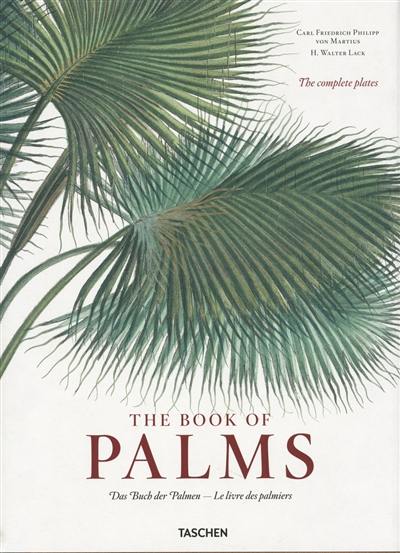
Collection(s) : XL
Paru le 28/06/2017 | Relié sous jaquette 412 pages
Tout public
texte de H. Walter Lack
Arbres de paradis
Toutes les espèces connues des palmiers en 240 illustrations raffinées
Le 15 décembre 1868, Carl Friedrich Philipp von Martius (1794-1868), professeur de botanique à l'université de Munich et directeur du Jardin botanique royal, est conduit à sa sépulture dans un cercueil recouvert de feuilles de palmier fraîchement cueillies, hommage à sa révolutionnaire Histoire naturelle des palmiers : une oeuvre en trois volumes, publiée entre 1823 et 1853. À cette époque, ce trésor encyclopédique rassemble toute la somme des connaissances humaines sur le sujet, et contient 240 illustrations chromolithographiques, notamment des paysages où poussent les palmiers et des dissections botaniques.
Cet ouvrage épique est le fruit de l'expédition de Martius au Brésil et au Pérou, en compagnie du zoologiste Johann Baptist von Spix. De 1817 à 1820, le duo a parcouru plus de 2250 km à travers le bassin de l'Amazone, la région la plus riche en palmiers au monde, collectant et dessinant les espèces. Dans ce travail hors pair, Martius établit la classification moderne et propose les premières cartes biogéographiques des palmiers, décrit tous les spécimens présents au Brésil et réunit toutes les espèces connues de la famille du palmier. Tout aussi remarquables, les paysages en couleur présentent diverses espèces de palmiers - figurés souvent seuls - d'une beauté simple et élégante. Cet ouvrage fameux constitue un monument inégalé de l'illustration botanique et de la taxinomie.
Trees of Paradise
All known genera of the palm family in 240 exquisite illustrations
On December 15, 1868, Carl Friedrich Philipp von Martius (1794-1868), Professor of Botany at the University of Munich and Director of the Royal Botanic Garden, was carried to his grave in a coffin covered with fresh palm leaves. These were a reference to his groundbreaking Historia naturalis palmarum : opus tripartitum (Natural History of Palms : A Work in Three Volumes), published between 1823 and 1853. At the time, this encyclopedic treasury contained the sum of human knowledge on the topic, and included 240 exquisite chromolithographic illustrations, including landscape views of palm habitats and botanical dissections.
This epic folio was based on von Martius's expedition to Brazil and Peru with zoologist Johann Baptist von Spix. From 1817 to 1820 the pair traveled over 2,250 km (1,400 miles) throughout the Amazon basin, the most species-rich palm region in the world, collecting and sketching specimens. In his work, von Martius outlined the modern classification of palm, produced the first maps of palm biogeography, described all the palms of Brazil, and collated the sum of all known genera of the palm family. Especially remarkable are the color landscapes showing various palms - often standing alone - which have a simple and elegant beauty. This famous work is an unrivaled landmark in botanic illustration and taxonomy.
« This book is a pleasure to own, to leaf through and to admire, and Taschen are to be congratulated for realizing such a monumental work. »
- The european Palm Society, Richmond
« A landmark in taxonomic description, botanical illustration, and the realistic representation of species in the landscape. »
-Financial Times, London
Bäume des Paradieses
Alle bekannten Palmenarten in 240 erlesenen Illustrationen
Am 15. Dezember 1868 wurde Carl Friedrich Philipp von Martius (1794-1868), Professor für Botanik an der Universität München und Direktor des Botanischen Gartens, in einem mit frischen Palmblättern bedeckten Sarg zu Grabe getragen - eine unverkennbare Referenz an seine bahnbrechende Historia naturalis palmarum : opus tripartitum (Naturgeschichte der Palmen : ein Werk in drei Bänden), die zwischen 1823 und 1853 erschienen war. Diese enzyklopädische Schatzkammer barg seinerzeit die Summe des menschlichen Wissens über Palmen und enthielt 240 erlesene Farblithografien, darunter botanische Schnitte und Gesamtansichten von Palmenhabitaten.
Grundlage dieser umfassenden Folio-Ausgabe war Martius' gemeinsame Expedition mit dem Zoologen Johann Baptist von Spix nach Brasilien und Peru. Zwischen 1817 und 1820 legten beide Forscher sammelnd und zeichnend mehr als 2250 Kilometer innerhalb des Amazonasbeckens zurück, der weltweit artenreichsten Palmenregion. Martius legte so die Grundlagen für die moderne Systematik der Palmen, erstellte die ersten Karten über ihre Verbreitung, beschrieb sämtliche Palmenarten Brasiliens und präsentierte einen kritischen Vergleich aller bekannten Gatungen der Palmenfamilie. Einen besonderen Reiz seines Werkes bilden in ihrer schlichten und eleganten Schönheit die farbigen Landschaften mit diversen - oftmals einzeln stehenden - Palmen. Dieses berühmte Opus ist ein unerreichter Meilenstein der botanischen Illustration und Taxonomie.
H. Walter Lack est professeur à l'Université libre de Berlin et l'ancien directeur du Jardin botanique et du Musée botanique de Berlin-Dahlem. Il est spécialiste de l'histoire de la botanique et travaille surtout sur les conséquences historico-culturelles du transfert des plantes utiles et des plantes d'agrément à travers le monde. Il a publié chez TaschenUn Jardin d'Eden et Le livre des palmiers.
H. Walter Lack is a Professor at the Free University of Berlin and former Director of the Botanical Gardens and Botanical Museum in Berlin-Dahlem. A leading expert in the history of botany, his research focuses on the global transfer of useful and ornamental plants from a cultural historical perspective. He is the author of Taschen's A Garden of Eden and The Book of Palms.
H. Walter Lack ist Professor an der Freien Universität Berlin und war bis August 2014 Direktor am Botanischen Garten und Botanischen Museum Berlin-Dahlem. Er ist einer der herausragenden Experten der Geschichte der Botanik und hat vor allem über die kulturgeschichtlichen Folgen des globalen Transfers von Nutz- und Zierpflanzen geforscht. Bei Taschen sind von ihm Ein Garten Eden und Das Buch der Palmen erschienen.